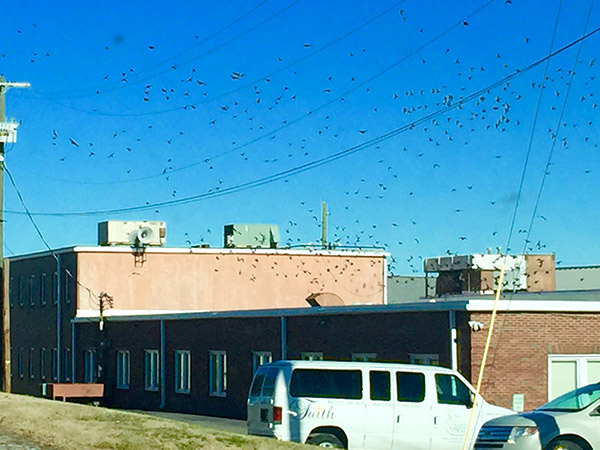Jackson Starling Control
 Animal Pros starling removal and control solutions for starlings, grackles, and blackbirds, offers professional bird control to Jackson Tennessee. Has your home or business been overwhelmed by starlings? You have came to the right place. Starlings can damage a number of things in relation to a home or business. Damage can occur to vents, insulation, stone, masonry, metal, machinery, drainage, and roofs. Bird in your store can quickly become a health issue. Roosting, nesting, loafing, and feeding areas can all be major attractions to keep birds in your area. Contact one of our certified specialist for expert bird solutions for your starling problems.
Animal Pros starling removal and control solutions for starlings, grackles, and blackbirds, offers professional bird control to Jackson Tennessee. Has your home or business been overwhelmed by starlings? You have came to the right place. Starlings can damage a number of things in relation to a home or business. Damage can occur to vents, insulation, stone, masonry, metal, machinery, drainage, and roofs. Bird in your store can quickly become a health issue. Roosting, nesting, loafing, and feeding areas can all be major attractions to keep birds in your area. Contact one of our certified specialist for expert bird solutions for your starling problems.
Contact a Animal Pros professional, our starling service includes:
- An on site, no obligation evaluation.
- Inspection of activity, roosting, and nesting.
- Inspection of damage, droppings, and problem.
- Professional deterrent installation recommendations.
- Starling removal options.
- Options to fit a budget.
- Realistic expectations.
- Permanent Solutions.
Animal Pros starling deterrents include bird spikes, electric shock track, bird wire, bird netting, laser deterrent technology, and more. Our ProTeam specialists can repair any opening birds may be entering, ensuring a permanent solution. Droppings are usually a major concern from a starling problem, and our restoration specialist can remove nesting, and clean, disinfect, sanitize, and deodorize any affected area of damage. Droppings and nesting can be hazardous, as removal should only be attempted by a trained professional. Contact one of our specialists today, as we are state certified, bird deterrent certified, aerial lift certified, and certified urban marksman. Most bird issues are a health and safety issue and do need immediate assistance, and we are available 24 hours a day, and 7 days a week, for emergency help.
Common Nuisance Concerns
Starlings are labeled as a nuisance pest bird, and they have adapted well to city living. Starlings will often seek architectural designs of building rooftops, ledges, signs, I-beams, and abandoned buildings that offer shelter. When starlings increase in numbers, activity can become damaging to any building or home around. Common nuisance complaints we receive include:
- Starlings on a rooftop.
- Starlings in a warehouse.
- Starlings on I-beams.
- Starlings in a attic.
- Starlings in the eaves or window dormers.
- Droppings all over a building.
- Nesting and droppings clogging the gutter.
- Contamination of food and products.
- Damage to machinery.
- Damage to ventilation system.
- Starlings in the soffit.
- Starling control at a airport.
- Starling control for a military base.
European Starling (Sturnus vulgaris)
- Height: 5″-6″
- Diet: Grainivorous and Frugivorous, eating grains and fruits, and insectivorous.
- Breeding: Triggered by food availability and can occur year round.
- Gestation: 12 Days.
- Reproduction: 4-6 eggs.
- Habitat: Urban areas, common around man-made structures and public areas with the availability of food.
- Legal Status: Common throughout Tennessee, and under no protection.
- Other Names: Starling, Grackles, and Black Birds.
- Interesting Facts: The Starling, is often confused for other animals in homes, because it can be heard walking or running. Starlings are communal birds often found in flocks of hundreds to thousands
Jackson Starling Removal
Starling removal is often needed to remove the number of birds to a acceptable level. In certain situations, removal may not be necessary with the right deterrent installed, as the starlings will no longer be able to roost there. Starling removal is often performed by live traps or trapping, shooting, and deterrents. Contact a professional at Animal Pros for expert help in removing starlings. In addition to being bird deterrent certified, we are also certified urban marksman.
Why are Starlings Attracted To a Building?
Starlings are commonly attracted to architectural buildings and man-made structures, utilizing structural protected areas that offer shelter from the environment. Starlings will usually stay in these areas especially if they are fed, and have a adequate water source. Simple modification of certain areas experiencing pigeon problems can make a long term solution. Starlings will commonly be drawn to level, flat ledges, I-beams, roofs, roof vents and AC units, shelfs, gutters, peaks, light posts, signs, and other area that offer protection. For warehouses with open bay or dock doors, this creates a open invitation, and starlings will take advantage of. Starlings are highly dependent of human activity, and will often be found in city buildings, parks, feed mills, yards, electric wires, bridges, and other structures.
Starling Damage From Droppings
Starlings can create a huge mess of droppings and nesting that can hold bacteria and pathogens, as there are more than 25 human communicable diseases associated with starling droppings. As the birds continually move over dried droppings, fungus spores or fecal particulates can become airborne. Histoplasmosis is one of the most common zoonotic diseases associated with starling droppings, therefore professional help is recommended. This can be a issue if roosting next to a ventilation system on a roof, directly overhead of a public walkway, or in a warehouse. Starling Droppings are so highly corrosive , we have seen them eat through metals. Droppings will accelerate the deterioration of a building, and increase costs of maintenance greatly. Contact a Animal Pros bird specialist today for remediation and clean up of bird droppings at your home or business.
